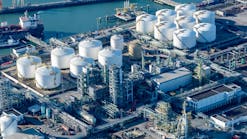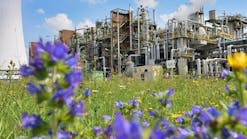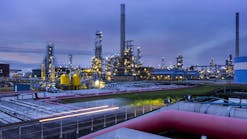Gazprom Neft advances Moscow refinery revamp
JSC Gazprom Neft has gained final approval from Russian government regulators to begin construction on its long-planned combined oil refinery unit (CORU) upgrade and modernization project at the 12.15 million-tonne/year Moscow refinery (OGJ Online, May 7, 2013).
Russia’s federal building standards and quality-control agency Glavgosekspertiza has approved final project documentation for the CORU, which is designed for primary distillation of crude oil to produce high-octane Euro-5 standard gasoline, diesel fuels, and vacuum gas oil, Gazprom Neft said.
The CORU plant, which will replace outdated equipment and be fully compliant with Russia’s current ecological standards and environmental regulations, will involve installation of the following:
• A 6 million-tonne/year (tpy) primary atmospheric -vacuum distillation unit (CDU-VDU 6);
• A 1 million-tpy gasoline reforming unit.
• A 2 million-tpy diesel (distillate) hydrotreating unit, which will include an iso-dewaxing unit.
• A gas fractionation unit.
• An amine regeneration unit.
In addition to boosting crude processing at Moscow to the refinery’s full nameplate capacity, the CORU plant, once commissioned, will improve the complex’s operational energy efficiency as well as increase its inter-maintenance period to 4 years from a current 2 years, the company said.
The project also will reduce the refinery’s total environmental impact from processing activities by 11%, according to Gazprom Neft.
Construction on the new plant is scheduled to begin by yearend, with start-up due third-quarter 2018.
In June, Gazprom Neft let a contract to Tecnimont SPA, a subsidiary of Maire Tecnimont SPA, Milan, for engineering, procurement, and construction management services for the CORU project, which comes as part of the second phase in the company’s program to modernize and upgrade its Russian refineries to improve processing capacities, oil conversion rates, energy efficiency, production quality, and environmental impacts over 2013-20 (OGJ Online, Jun. 19, 2015; Jan. 14, 2015; Dec. 3, 2014).
Other second-stage modernization work at the Moscow refinery includes the following:
• Start-up of a newly reconstructed and refurbished sulfur-recovery unit, which the company commissioned in October (OGJ Online, Oct. 3, 2014).
• Installation and commissioning of an automated air-monitoring system at Moscow’s key units as part of the refinery’s modernization program, which was completed in April 2015.
• A furnace improvement efficiency project, which the company began in 2014, that involves installation of furnaces and renovation of existing ones to enable the refinery to increase furnace efficiency to 90% and reduce sulfur dioxide emissions from the site by more than 95%.
A project to reconstruct and revamp the Moscow refinery’s existing catalytic cracking unit to increase processing capacity also is planned, as are projects to construct hydrocracking and flexicoking units at site.
Once fully completed, the modernization program at Moscow will increase overall design capacity of the refinery to 18.15 million tpy.
Contact Robert Brelsford at [email protected].


